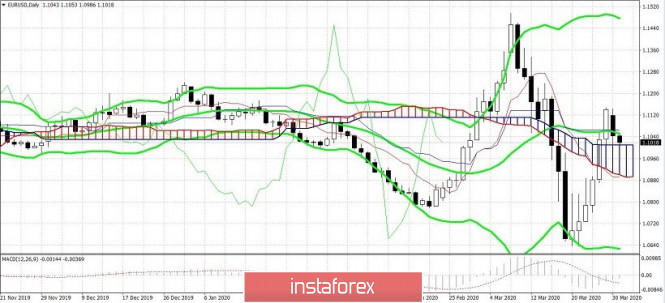The euro-dollar pair showed a downward track during the Asian session on Tuesday, but still remained within the 10th figure. Bears failed to break through the support level of 1,1010 yesterday (the upper limit of the Kumo cloud on D1) – as soon as sellers touched this target, they attracted the attention of buyers, who returned the pair to the middle of the 10th price level. However, bearish sentiment still continues to dominate: today, EUR/USD again entered the ninth figure, trying to confirm the strength of the downward movement. Judging by the persistence of the bears, the pair will still drop a step lower, while the further vector of price movement is still in question.
By and large, the future fate of all dollar pairs will depend on the overall attitude of investors to the US currency. The rapid growth of the greenback in mid-March was caused by panic: the dollar became the only lifeline for which all investors simultaneously reached out, throwing off less liquid assets. Such excitement helped dollar bulls to survive difficult times, when the Federal Reserve lowered the rate at extraordinary meetings, launching the printing press along the way. The US currency simply ignored all the decisions of the Fed, maintaining the safe-haven status and the most popular currency in the world.

However, further events were able to suspend the US dollar's growth – the Fed opened dollar swap lines with the ECB, the Bank of Japan and the Bank of England and nine other central banks slightly reduced the excitement around the greenback. Jerome Powell announced a $700 billion quantitative easing program, and later lifted the threshold and made the program unlimited in amount. The Fed also opened credit lines for corporations, states, and local governments. The Fed chief noted that the current purchases of US Treasury and mortgage-backed securities will be expanded "as much as necessary". In addition, there are rumors on the market that in the event of further revaluation of the greenback, the G7 countries may take a coordinated decision to "curb" it, organizing, for example, a "big dollar sell-off".
This fundamental background made it possible for the EUR/USD bulls to take revenge, raising the price to the middle of the 11th figure. However, buyers also failed to rise above this level, against the backdrop of a failed online summit of EU leaders. In addition, the dollar is still considered by the market as the most reliable defensive asset, so as soon as the upward momentum began to fade, traders began to take profits, closing long positions.
The dollar has gradually gained momentum, but there is another side of the coin: important macroeconomic reports will be published this week in the US (ISM indices, Nonfarm payrolls, the number of applications for unemployment benefits, etc.), which may alert and scare traders from the US currency. According to preliminary estimates, the report results will be disastrous – for example, for the first time in many years, the growth rate of employment in the non-agricultural sector will fall into negative territory.
Thus, from a fundamental point of view, the pair was at a crossroads: on the one hand, the dollar retains the status of a defensive asset, on the other hand, it is potentially under the impact of extremely negative macroeconomic reports. For EUR/USD bulls, there is a risk that traders will ignore the weak figures, and against all odds will continue to invest in the US currency. However, the pair's bears are also exposed to a similar risk, especially if the releases turn out to be even worse than the extremely weak forecasts. In this case, the US economy will scare investors away from the dollar. Which of the two scenarios will be implemented is an open question. The answer can be found when the Nonfarms data is published at the end of the week.

From a technical point of view, there is a similar picture of uncertainty: on the daily chart, the price is located on the middle line of the Bollinger Bands indicator, and the trend indicators have not formed any clear and unambiguous signals. However, if buyers still show character and the pair is consolidated above the 1.1070 mark (the average line of the Bollinger Bands indicator coincides with the Kijun-sen line on the daily chart), the Ichimoku indicator will form a bullish Parade of Lines signal - in this case, it will be possible to consider long positions with the goal of 1.1147 (the local high reached on March 27). But if the bears finally settle below the level of 1.1010 (the upper limit of the Kumo cloud on D1), then short positions will be prioritized here (with the goal of 1.0880) – with a high probability, the downward dynamics will strengthen, and the pair will reach the lower limit of the above cloud. Thus, the intermediate support level is 1.1010, while the stronger level is 1.0880 (the lower boundary of the Kumo cloud on D1 coincides with the Tenkan-sen line). The price ceiling (resistance level) is the local high of 1.1147.
The material has been provided by InstaForex Company - www.instaforex.com